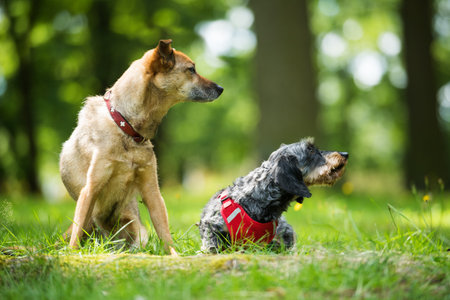Understanding Dog Socialization
Socializing your dog means more than just letting them meet other dogs at the park—it’s about exposing them to a variety of people, animals, environments, and situations in a positive way. In American society, where dogs often accompany us to busy parks, coffee shops, or even outdoor events, proper socialization is essential for a well-adjusted pet. Well-socialized dogs are less likely to develop behavioral issues such as aggression, anxiety, or excessive barking. They also handle everyday experiences—like meeting the mail carrier or hearing fireworks on the Fourth of July—with greater confidence and calm. Socialization improves your dog’s mental health by reducing fear and stress, making it easier for them to adapt to new experiences. Ultimately, a well-socialized dog is not only happier but also safer and more enjoyable to be around in daily American life.
2. Why Socializing Your Dog Matters
In the United States, socializing your dog is more than just a trend—it’s a vital part of responsible pet ownership. Dogs that are well-socialized tend to be happier, healthier, and easier to manage in everyday situations. Let’s break down why this is so important:
Prevents Behavioral Issues
Many common behavioral problems—such as aggression, anxiety, and excessive barking—stem from poor socialization. When dogs aren’t exposed to different people, animals, and environments early on, they may react fearfully or aggressively to new experiences. By gradually introducing your dog to a variety of situations, you help them develop confidence and reduce the likelihood of negative behaviors.
Keeps Your Dog Comfortable in American Life
Life in the U.S. often means trips to parks, vet offices, dog-friendly stores, and neighborhood gatherings. A socialized dog will feel at ease around strangers, children, other pets, and unfamiliar settings—making these outings enjoyable for both of you. For example, think about visiting a busy outdoor cafe: a well-socialized dog can calmly sit by your side while people walk by or other dogs pass through without reacting negatively.
Benefits of Dog Socialization
| Benefit | Real-Life Example |
|---|---|
| Reduces aggression | Your dog stays calm when meeting new dogs at the park |
| Lowers anxiety | Your dog doesn’t panic during July 4th fireworks or crowded events |
| Makes vet visits smoother | Your dog remains relaxed when handled by veterinary staff |
| Improves adaptability | Your dog adjusts easily when you move to a new home or travel together |
Building Trust with Your Community
A well-socialized dog is a great ambassador for all dogs in your neighborhood. When your pet behaves politely on walks or interacts gently with children at community events, it helps build trust with neighbors and promotes positive attitudes toward dogs in public spaces. In many American cities and suburbs where leash laws and pet regulations are common, having a well-socialized dog also means fewer complaints and a safer environment for everyone.

3. Best Ages and Stages for Socialization
Understanding when to socialize your dog is just as important as knowing how. Dogs go through critical periods in their development that shape their behavior and comfort with the world around them. For puppies, the most sensitive window is between 3 and 14 weeks old. During this stage, puppies are naturally curious and more accepting of new experiences, people, sounds, and other animals. Exposing a puppy to diverse situations—like meeting friendly neighbors at the park, hearing household noises, or visiting a pet-friendly store—can lay the foundation for a confident, well-adjusted adult dog.
However, socializing isn’t just for puppies. Many American families adopt older dogs or rescues who may have missed early socialization. While it’s true that adult dogs can be more cautious or nervous when faced with new situations, it’s never too late to help them adjust. Socializing adult dogs requires patience and a slower approach—think short visits to calm environments and gradual introductions to new people or pets. The pros of starting early with puppies include easier adaptation and fewer ingrained fears. On the flip side, socializing adult rescues can be more challenging but also deeply rewarding as you witness real progress over time.
Whether you’re working with a playful pup or a shy rescue, recognizing these developmental stages allows you to tailor your approach. Remember: positive experiences at any age build trust and set the stage for lifelong good behavior in your dog.
4. Practical Ways to Socialize Your Dog
Helping your dog become comfortable and well-behaved around other people, pets, and environments takes real-world practice. In the U.S., socializing your dog is as much about teaching good behavior as it is about building confidence and trust. Let’s look at some practical strategies—complete with familiar American settings—that you can use to set your pup up for success.
Visit Dog Parks
Dog parks are a staple in many American neighborhoods and provide an excellent opportunity for dogs to interact off-leash with others. Start by observing from outside the fence to see how your dog reacts, then gradually introduce them during less busy times. Always monitor their body language and step in if they seem overwhelmed or too excited. Remember, every dog park has its own community vibe—find one that matches your dog’s energy level.
Walks in Neighborhoods
Regular walks around your neighborhood expose your dog to a variety of sights, sounds, and smells—from strollers and bikes to mail carriers and kids playing basketball in driveways. These everyday encounters help normalize distractions and teach polite leash manners. Try varying your routes so your dog becomes accustomed to new experiences, like passing by schoolyards or construction sites.
Dog-Friendly Cafes and Stores
Many American cities now feature cafes, breweries, and retail stores that welcome dogs. Taking your pup to these spots offers valuable experience with crowds, noises, and different types of people. Before going inside, make sure your dog knows basic commands such as “sit” and “stay,” which will help them settle calmly under a table or beside you while you enjoy a coffee.
Hosting Playdates
Inviting friends or neighbors over for doggy playdates is another effective way to socialize your pet in a controlled environment. Start with just one other dog that you know is friendly and fully vaccinated. Allow both dogs to meet on neutral territory (like the front yard) before letting them loose together indoors or in the backyard. Gradually increase group size as your dog becomes more comfortable.
Tips for Safe and Positive Introductions
| Situation | What To Do |
|---|---|
| Meeting New Dogs | Keep both dogs leashed at first; walk parallel with space between before allowing sniffing. |
| Interacting With Strangers | Ask people to approach slowly; let your dog choose whether or not to say hello. |
| Loud/Busy Environments | Bring treats; reward calm behavior; keep sessions short to avoid overwhelming your pup. |
| At-Home Visitors | Give your dog a safe space (like a crate or separate room) if they need breaks from guests. |
The key is consistency and patience. Every outing is a chance for positive reinforcement—use praise and high-value treats when your dog handles new situations well. By using these practical approaches within familiar American contexts, you’ll help your dog build confidence and develop into a happy, well-mannered companion.
5. Common Mistakes and How to Avoid Them
Even with the best intentions, many American dog owners run into trouble when socializing their dogs. Here are some frequent missteps and how you can steer clear of them for a smoother experience.
Overwhelming Your Dog Too Quickly
Pushing your pup into busy parks or loud events right away can backfire. Dogs, like people, need time to adjust. If your dog is flooded with too many new faces, noises, or smells at once, it can cause anxiety or even aggression.
How to Fix It
Start small. Introduce your dog to one new person or pet at a time in a calm setting. Gradually work up to busier environments as your dog’s confidence grows.
Lack of Consistency
Socialization isn’t a one-and-done task. Many owners stop exposing their dogs to new experiences after puppyhood, which can lead to fear or reactivity later on.
How to Fix It
Make socialization part of your routine. Take different walking routes, invite friends over regularly, and continue introducing your dog to new sights and sounds throughout their life.
Ignoring Your Dog’s Body Language
Some owners overlook warning signs like tucked tails or lip licking, pushing their dogs to “just deal with it.” This can create negative associations with social situations.
How to Fix It
Pay attention to what your dog is telling you. If they seem uncomfortable, give them space or take a break. Respecting their boundaries builds trust and helps them learn at their own pace.
Relying Only on Dog Parks
Dog parks are popular in the U.S., but they’re not always the best place for every dog—especially those who are shy or inexperienced.
How to Fix It
Mix up your socialization spots: neighborhood walks, pet-friendly stores, or training classes offer controlled environments that set your dog up for success.
Lack of Positive Reinforcement
If owners don’t reward good behavior during socialization, dogs might not understand what’s expected of them.
How to Fix It
Praise and treat your dog when they interact calmly and confidently with new people, pets, or places. This encourages repeat positive behavior and makes learning fun for both of you.
6. Troubleshooting Setbacks
Even with the best intentions, socializing your dog doesn’t always go smoothly. Many pet owners in the U.S. encounter common roadblocks like shyness, fearfulness, or negative experiences during socialization. Here’s how to tackle these issues while keeping up with a busy American lifestyle.
Understanding Common Socialization Challenges
Dog Shyness
If your pup seems hesitant around people or other dogs, don’t force interactions. Instead, start small: arrange brief encounters with calm, friendly dogs or neighbors you trust. Reward your dog for brave behavior with treats or praise—positive reinforcement is key. Gradually increase exposure at your dogs pace, perhaps during morning walks when parks are less crowded.
Fearfulness and Anxiety
Fearful dogs may cower, bark, or try to hide. If this happens, step back and lower the intensity of new experiences. Try counter-conditioning by pairing scary things (like the sound of skateboards) with high-value treats. For busy Americans, short but frequent sessions fit better into daily routines than lengthy outings—five minutes before or after work can make a big difference.
Negative Experiences
If your dog has had a bad experience—like being snapped at by another dog—avoid similar situations for a while. Rebuild confidence through positive encounters with safe, familiar dogs or people. Consider local resources like group obedience classes that offer controlled environments and professional guidance.
Practical Tips for Busy Schedules
- Leverage everyday moments: invite friends over for coffee and let your dog observe from a safe distance.
- Use daycare or dog-walking services to expose your pet to new faces and environments while you’re at work.
- Join neighborhood apps (like Nextdoor) to connect with local dog owners for quick playdates during evenings or weekends.
When to Seek Professional Help
If setbacks persist despite your efforts, don’t hesitate to consult a certified dog trainer or behaviorist. Many offer flexible scheduling or virtual sessions to accommodate your lifestyle. Remember, patience and consistency are essential—every step forward counts!
7. When to Seek Professional Help
Even with your best efforts, some dogs may struggle with socialization due to their background, genetics, or early experiences. It’s important to recognize when your dog’s behavior goes beyond normal shyness or excitement and crosses into territory that may require expert intervention.
Recognizing Serious Behavioral Issues
If your dog shows persistent signs of aggression, such as growling, snapping, lunging, or biting—especially toward people or other animals—these are red flags. Likewise, if your dog freezes in fear, cowers excessively, or is unable to relax around new people or pets despite gradual exposure, it could indicate a deeper issue. Dogs who bark uncontrollably, destroy property due to anxiety, or refuse to eat in unfamiliar situations might also be struggling more than typical socialization can address.
When Normal Becomes Concerning
It’s natural for dogs to feel nervous in new situations or take time to warm up. However, if you notice behaviors worsening over time instead of improving, or if your dog’s reactions put themselves or others at risk, these are clear signals that basic training methods aren’t enough. For example, if your dog has bitten someone even once out of fear or reactivity, it’s time to consult a professional.
Consulting the Right Expert
In the United States, look for certified professionals like a Certified Professional Dog Trainer (CPDT-KA) or a veterinary behaviorist (DACVB). These experts use science-based methods and positive reinforcement to assess and modify behavior safely. Don’t wait until the problem escalates—early intervention often leads to better outcomes for both you and your dog.
Remember: Seeking help isn’t a failure—it’s an act of responsible pet ownership. By addressing serious behavioral issues with professional guidance, you’re giving your dog the best chance at becoming a confident and happy member of your family and community.


